The German Women’s National team is back at the Olympic games, with DFB-Frauen looking to once again win Olympic gold, last doing so at the 2016 edition of the games.
However, they find themselves placed in a potentially tricky group, matching up against Australia, the United States, and Zambia.
Interim coach Horst Hrubesch brings a very talented squad with him to France this summer.
However, they have not necessarily hit many heights since he took over in very strange circumstances from Martina Voss-Tecklenburg after their group stage exit at last summer’s World Cup.
He has not been able to find the right formation or best players to utilise in his starting XI, something that many German fans will be concerned about with the tournament on the horizon.
However, Hrubesch’s only goal is to win a gold medal this summer, with current Germany U17 coach Christian Wück replacing the 73-year-old after the 2024 Olympics.
This tactical analysis will analyse the side in more detail and look at how Hrubesch can get the best out of this talented squad in his last tournament in charge.
Predicted starting XI
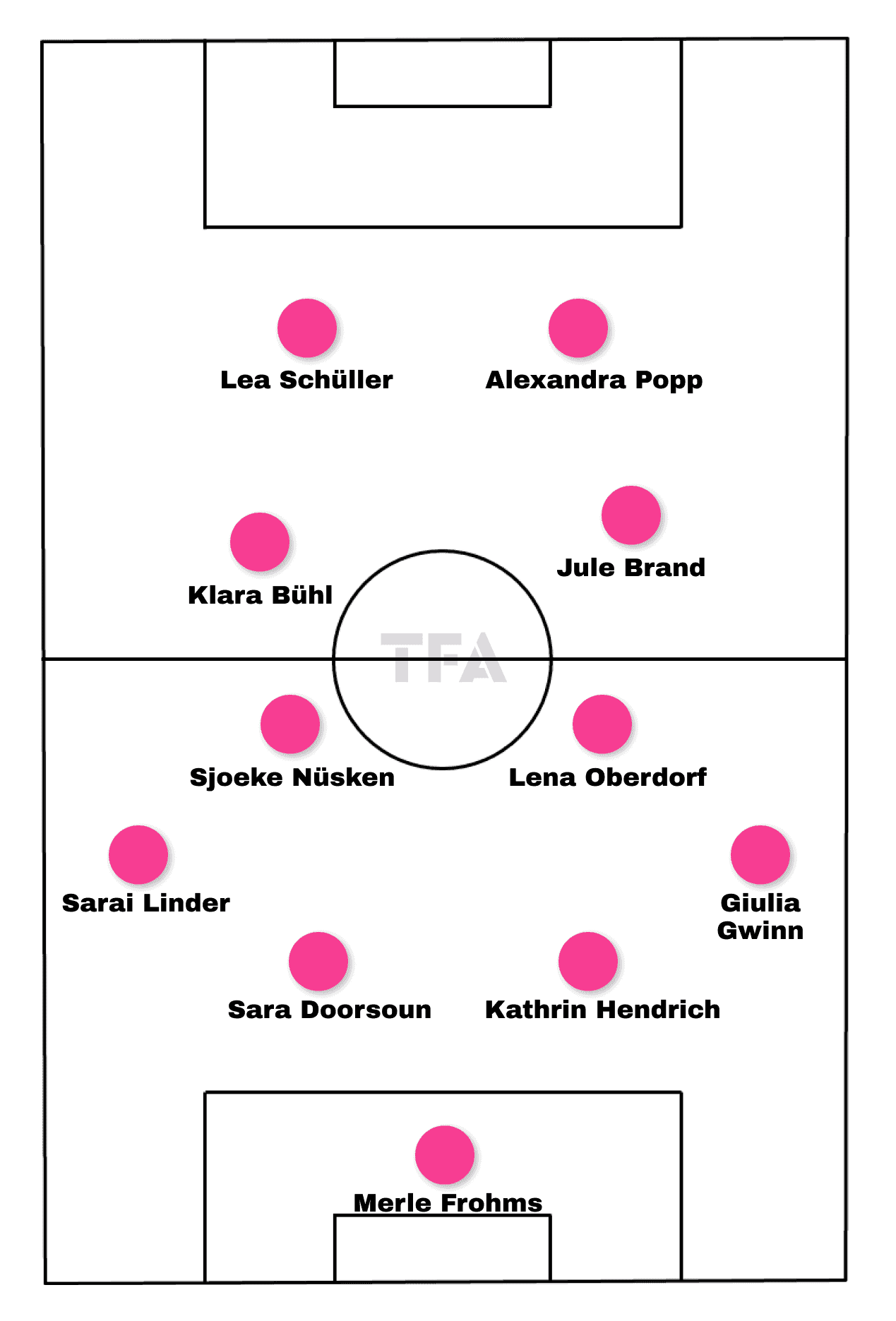
With such a talented squad at his disposal, it has sometimes seemed tough for Hrubesch to pick his best starting XI and formation.
In recent matches, he has rotated between playing a 4-2-3-1, a 4-4-2, a 4-2-2-2, or even a 4-3-3.
This constant change in formations and players has not helped Germany find a rhythm on the pitch.
We have predicted Germany will line up in a 4-2-2-2 formation, but this may look more like a 4-4-2 in certain phases of the game, especially when the Germans are out of possession.
In goal, Wolfsburg #1 Merle Frohms looks set to start, with the 29-year-old establishing herself as Germany’s preferred option in recent months.
At left back, Sarai Linder looks likely to keep her place in the side, with 32-year-old Sara Doorsoun starting next to her as the left-sided centre-back.
Her central defence partner will likely be Kathrin Hendrich, with the Wolfsburg defender being a mainstay in the German defence in recent months.
Athletic Bilbao centre-back Bibiane Schulze could also be a contender to start in one of the two centre-back positions, with the 25-year-old getting starts in recent matches under Hrubesch.
Bayern Munich defender Giulia Gwinn looks set to be Germany’s starting right back at this tournament, with the 24-year-old starting in every one of Germany’s matches this calendar year.
Moving into the midfield, and this is where the selection headaches have happened recently for Hrubesch.
The box midfield four has seemed to be the preferred choice for him in recent matches, with this being the formation of choice in their last two Olympic warm-up games against Poland.
Lena Oberdorf is a lock for one of the two defensive midfield positions, with the 22-year-old Wolfsburg midfielder one of the stars of this German side.
We have predicted that her partner in this deeper-lying position will be Chelsea midfielder Sjoeke Nüsken, but it could also well be Bayern Munich’s Sydney Lohmann, that starts alongside Oberdorf.
In the two advanced midfield positions, we feel Hrubesch will go with Klara Bühl alongside Jule Brand.
The two attacking midfielders will likely have the ability to roam freely around the pitch and have the potential to drift into wider areas to support the forwards.
22-year-old Vivien Endemann could also be in line to start in this area of the pitch, but it is more likely she sees most of her minutes at this tournament coming off the bench.
In the front two, Germany have two of the best goalscoring forwards in women’s football, with Bayern Munich’s Lea Schüller and Wolfsburg’s Alexandra Popp.
These two will be going to France with one thing on their minds: scoring goals to guide their nation to a second goal medal in their history.
Laura Freigang also offers Hrubesch another good forward option off the bench, with 13 goals for Eintracht Frankfurt in all competitions this past season.
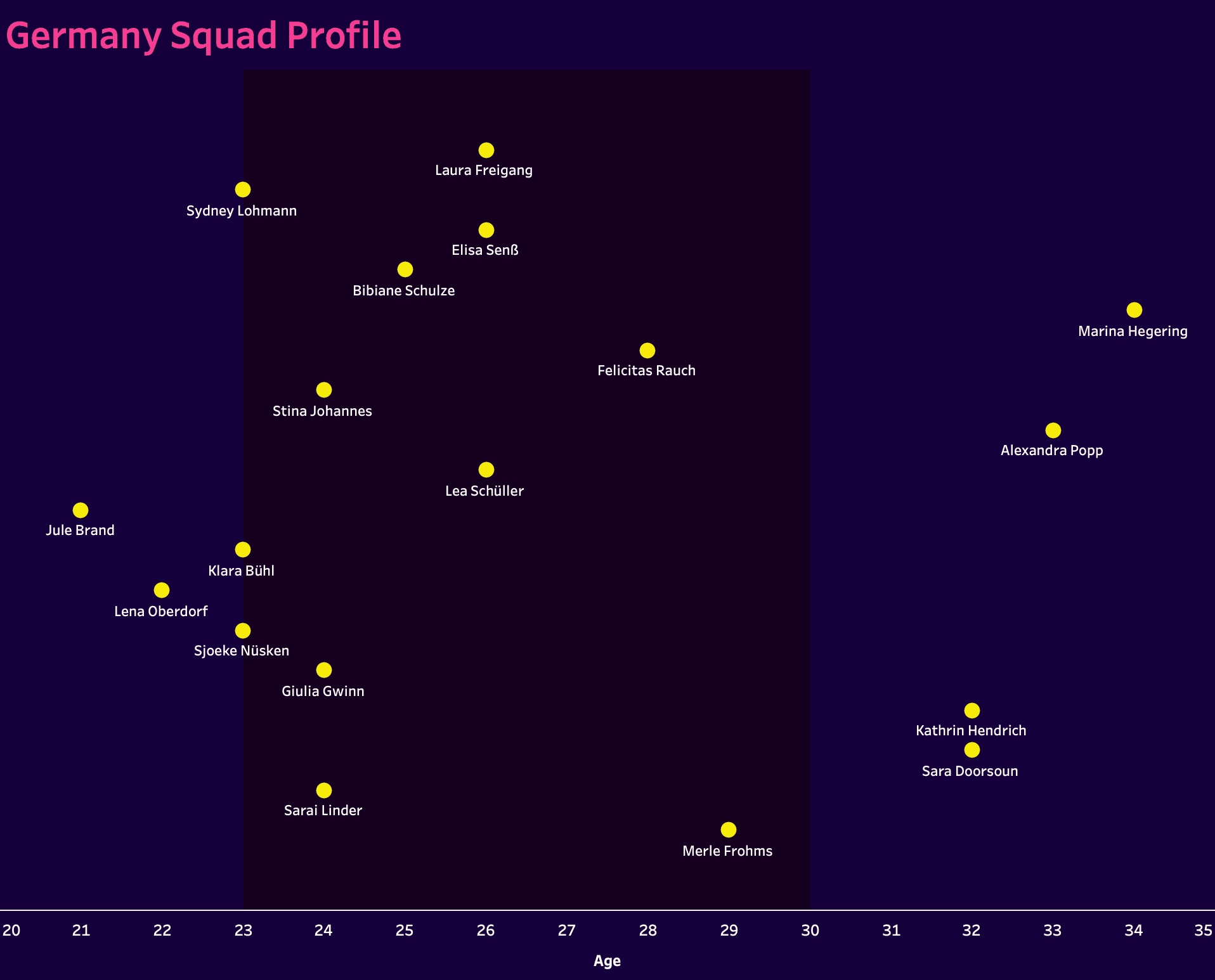
The graphic above shows the age profile of Germany’s squad at this tournament, and we can see how the majority of the squad are in or entering their prime footballing years.
Most of the players are between the ages of 23 and 30, with Hrubesch also having a good mix of veteran players who will bring leadership and tournament nous, as well as a couple of under-23 players who are massive talents in Brand and Oberdorf.
Attacking phase
From an attacking perspective, Germany are a side that look to often be on the front foot in matches, looking to put pressure on the opposition from the start and hold the majority of possession over the course of 90 minutes.
Due to this heavy attacking presence, the formational shape for Germany will change as they progress the ball into the attacking half of the pitch.
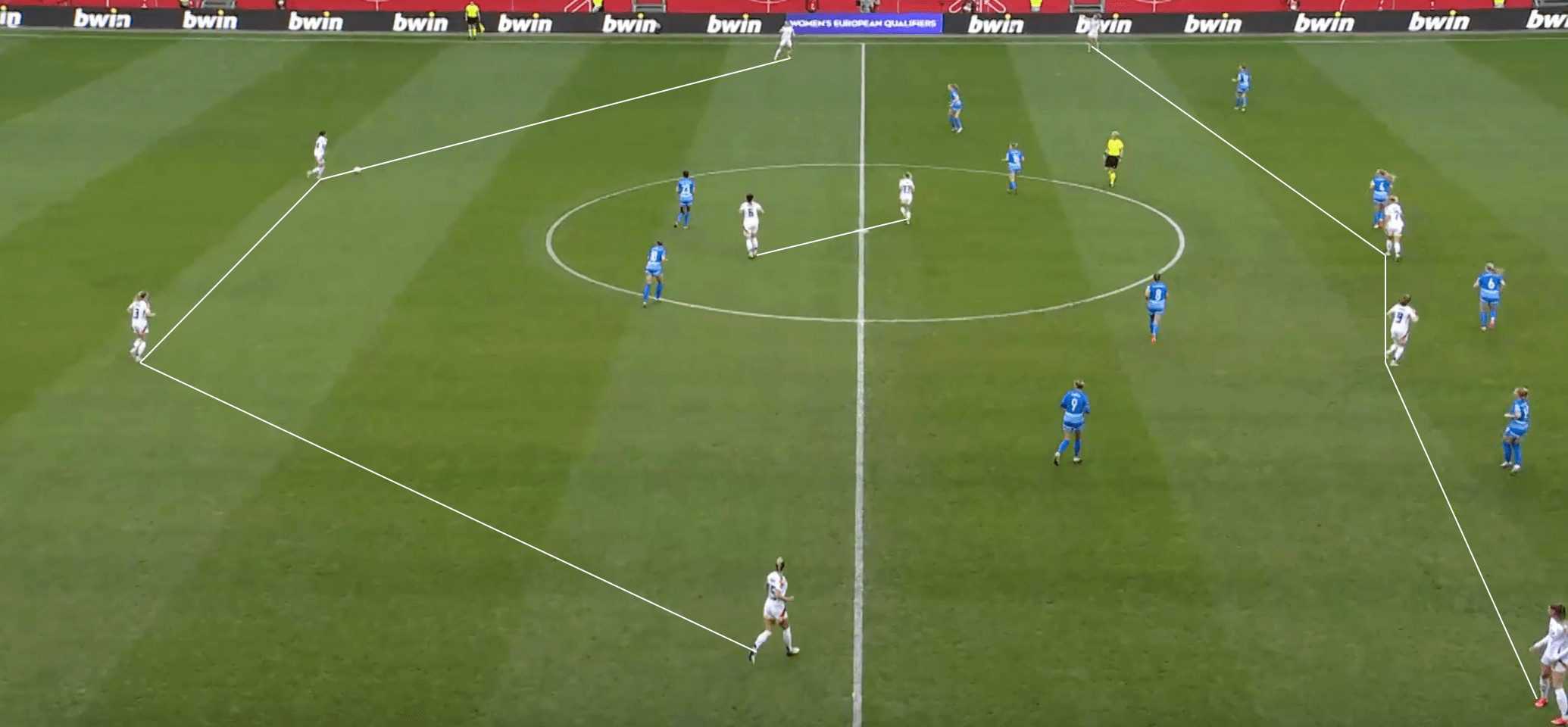
The figure above can give us a bit of a better idea of how Germany’s shape tends to look when they are in possession.
The 4-2-2-2 formation turns into more of a 4-2-4 at times, as we can see from the image above, with Hrubesch looking for his side to have maximum width in attack, as the two attacking midfielders move into wider positions, which looks to stretch the opposition defence.
Meanwhile, the weak side fullback will look to invert into more central positions to offer cover in central midfield when the ball is progressed into the attacking half.
In contrast, the ball side fullback will look to either underlap or overlap in the wide channel, offering support in attack or being the provider.
One of the main goals in attack for Germany is to progress numbers into the box in attacks, with the ball commonly looking to be worked out into the wide channels.
This allows the widely positioned attacking midfielders to drive at opposition fullbacks in possession, looking to drive past them before sending either crosses or low balls across goal into the box for runners to attack.
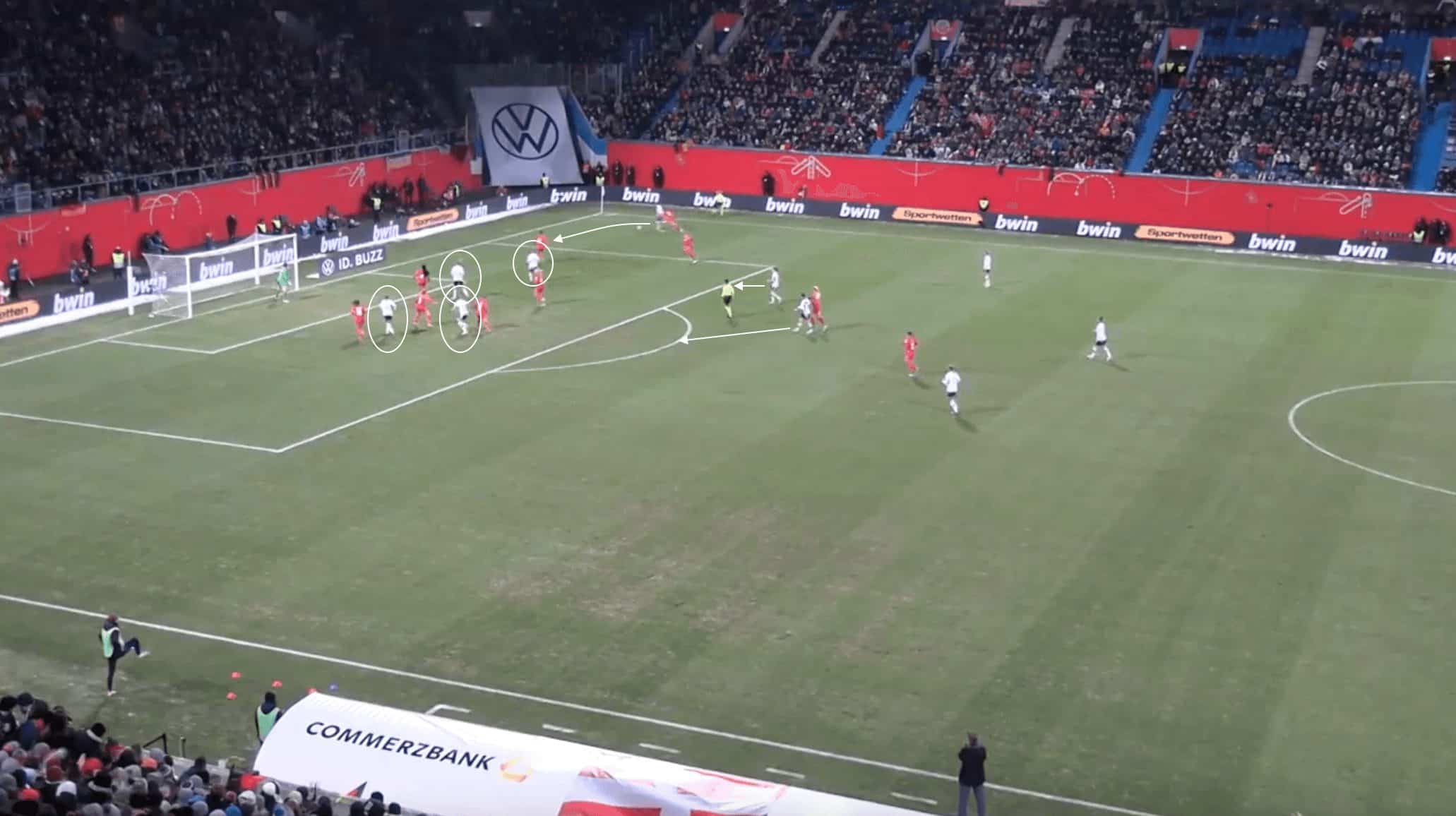
We just mentioned how Germany look to utilise width in their attacking moves and how they look to have a heavy presence in the penalty box to get on the end of crosses.
The image above shows an excellent example of this.
In this phase of play for Germany against Denmark, the ball is in possession of the fullback on the far side.
She receives possession in the wide channel, with the wide player driving inside to attract the opposition fullback and open the space for her to drive into after gathering possession from the centre-back.
Meanwhile, the four advanced German attackers all drive into the penalty box to be crossing options, while the defensive midfielders push forward and position themselves near the edge of the penalty area to look to gather any second balls the opposition defenders are able to clear, which keeps the opposition defence pinned in and under pressure.
This aggressive attacking movement off the ball has led to plenty of goals for Germany in recent matches, with opposition defences typically put under pressure for long spells in matches.
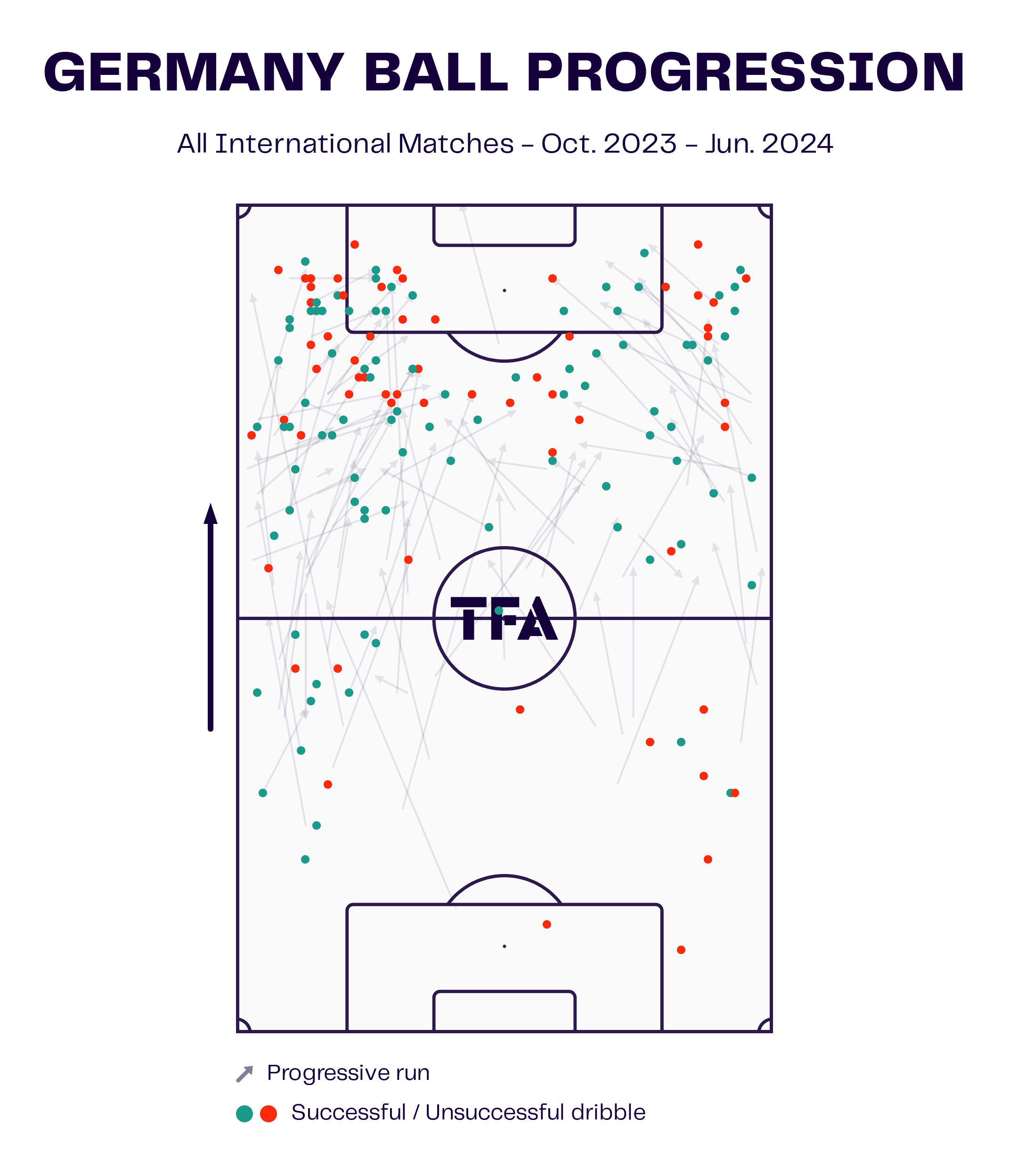
The data viz graphic above helps to give us a bit more insight into Germany’s ball progression since the back half of last calendar year.
We can see how most of Germany’s progressive runs and attempted dribbles have occurred in the wide channels or half-spaces.
They have tended to be more proficient when attacking down the left side, with most of their attacks coming down this flank.
Germany will be a threat down the flanks for opposition defences.
The numbers they push forward into attacking areas heaps constant pressure on opposition defences.
It will be interesting to see how the United States, Zambia, and Australia look to counter this high-octane German attack.
Defensive phase
From a defensive standpoint, Germany look to be aggressive and on the front foot, with them tending to hold a very high defensive line and push their defensive line up past midfield at times when in possession.
This tends to be a high-risk-high-reward defensive style of play, with the potential to be caught out in quick opposition transitional moments.
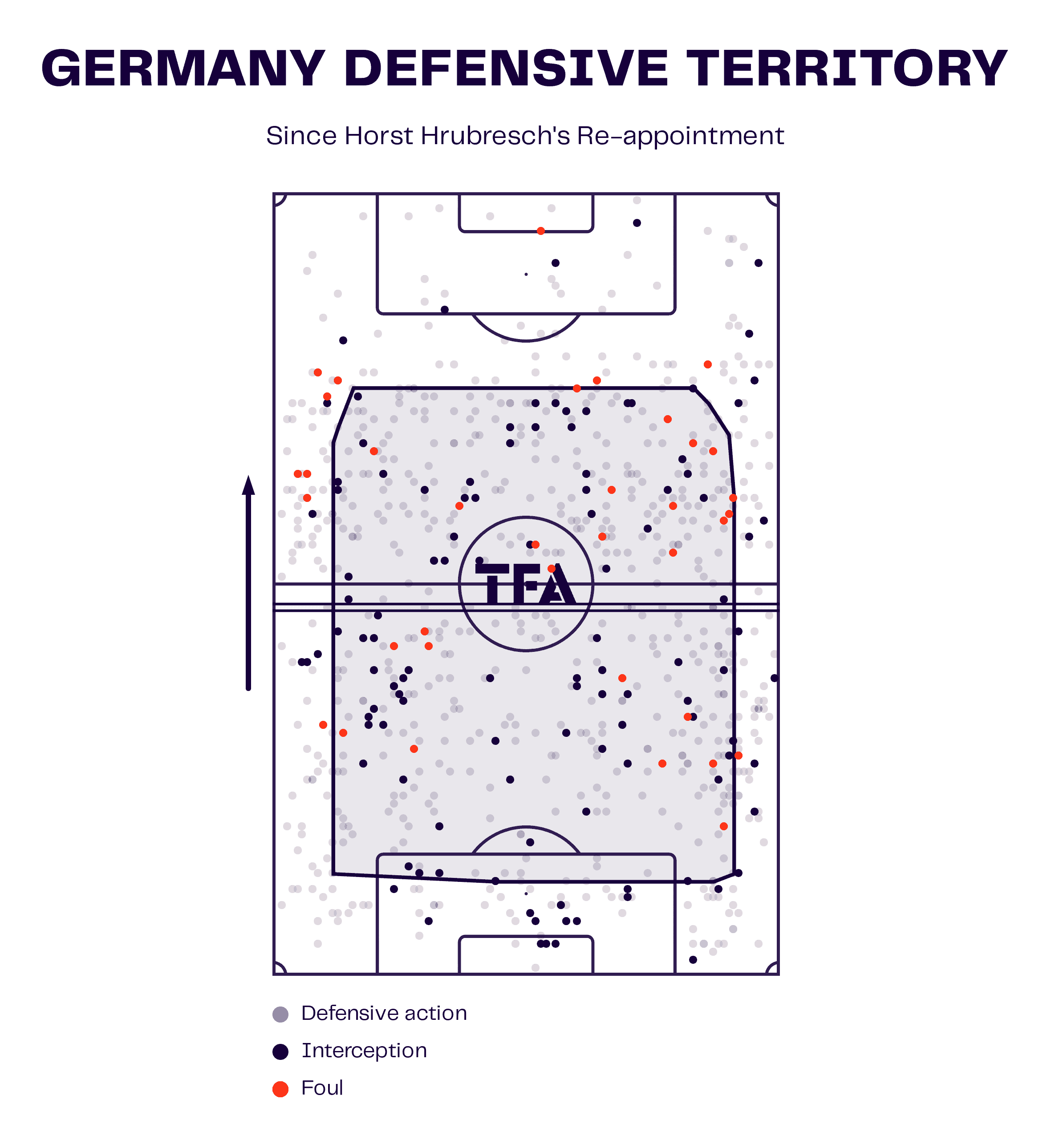
When looking at the data viz graphic shown above, we are able to see the average defensive territory of Germany since Horst Hrubesch’s re-appointments as interim head coach in October of last year.
The two horizontal lines near midfield represent the average height of Germany’s defensive line, as well as the average area of engagement.
A vast majority of their defensive actions also occur within the middle third or attacking third of the pitch, with winning the ball back in advanced positions a key part of Germany’s defensive style of play.
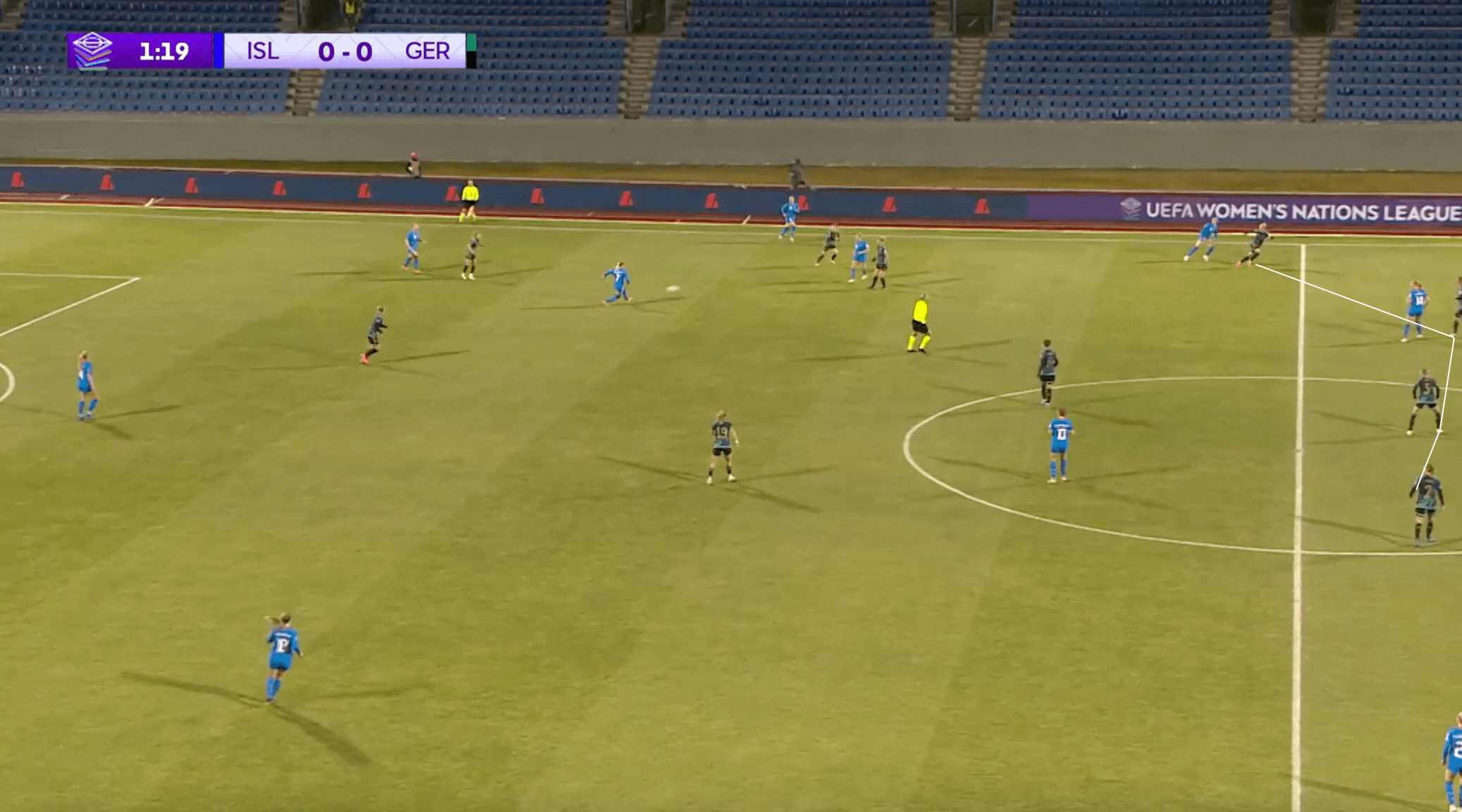
The data showed that Germany tends to hold a very high defensive line when the ball is turned over in the attacking third.
In the image above from this phase of play against Iceland, we can see how Germany looks to keep their defensive line high to put instant pressure on the opposition forwards when the ball is played forward.
In this specific phase of play, the ball is played from the midfielder, looking for a direct ball into the striker.
However, the centre-back is tight to the forward due to the high defensive line, and this tight positioning does not allow the Iceland forward to have a clear opportunity to gain possession.
As a result, the Germany centre-back is able to put the forward off, with the ball being shielded, allowing Germany to gather possession and restart play with the goalkeeper.
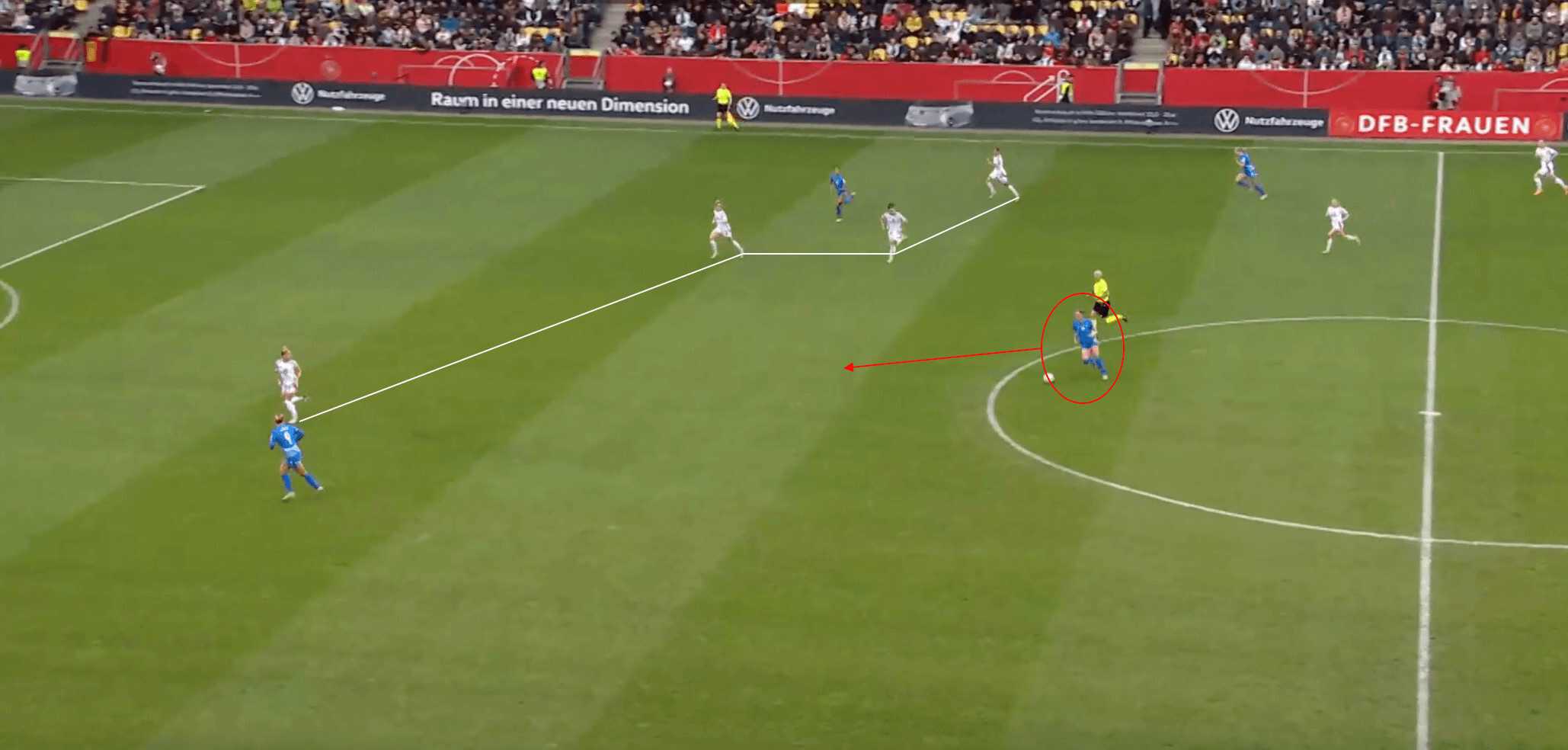
Due to Germany’s insistence on fielding a high line, issues are destined to arrive at crucial moments in matches for Horst Hrubesch’s side.
This phase of play, again against Iceland, shows where the weaknesses lie in Germany’s defensive approach.
This German defensive phase starts in their attacking half, with possession being turned over for Iceland to recover.
One of the German centre-backs steps out of the defensive line and into midfield, looking to anticipate a pass to an opposition midfielder.
However, the opposition are able to catch this player out, with a one-two being played with the Iceland forward, who does well playing back to goal.
This allows the midfielder to receive and drive into plenty of space between the midfield and defensive lines of Germany, as we can see from the figure above.
This time, the German defence is forced to drop in an attempt to get back into a defensive shape, but they are caught out, with Iceland able to overload the fullback at the back post with a 2v1.
The ensuing cross is played towards this area with Iceland able to score.
While Germany have been a solid defensive side with this aggressive style of high-risk, high-reward defending, they can be played through, and elite sides, namely the United States in their Olympics group, will likely be able to punish any defensive errors.
Transitions
From a statistical perspective, Germany are not a side that look to play much in transition, as they tend to look to dominate proceedings.
However, this is not to say they are not dangerous when they are able to win possession back in advanced areas, with the talent that they possess making them clinical in transitional moments.
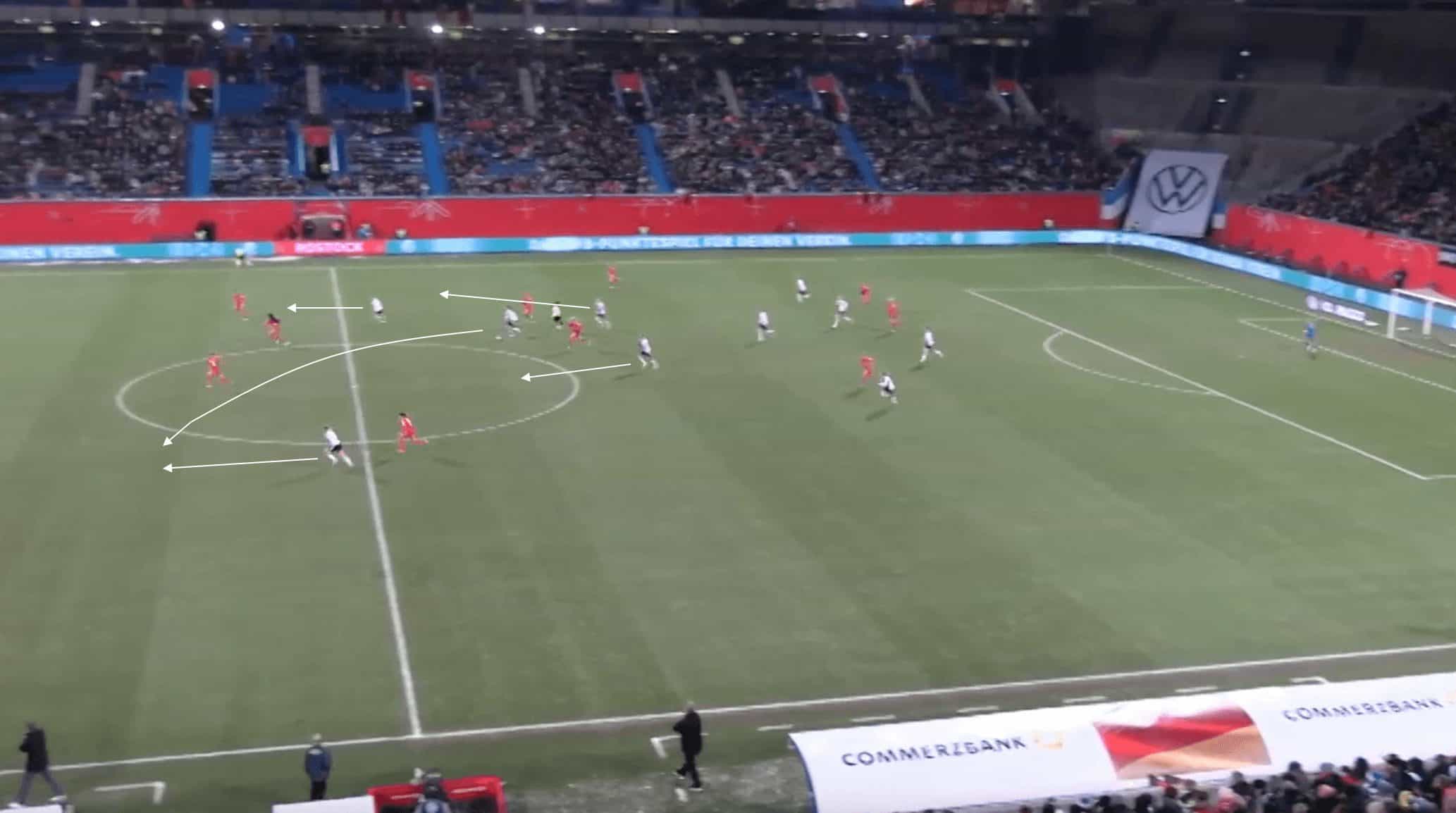
When talking about the threat that Germany offers in transitional moments, the image above gives a bit of an idea of how dangerous they can be in these moments.
In this phase of play above against Denmark, the ball is won back in the defensive half of the pitch by Germany, with the only thought to quickly play vertically.
The German forwards are quick to spring forward, with the two splitting and looking to make vertical runs that pull the opposition defence apart.
Meanwhile, the midfielder in possession drives forward to the edge of the attacking half before looking to pick out the forward, making a run beyond the advanced Danish fullback on the near side, with Hrubesch’s side still looking to attack the wide channels in transitional moments.
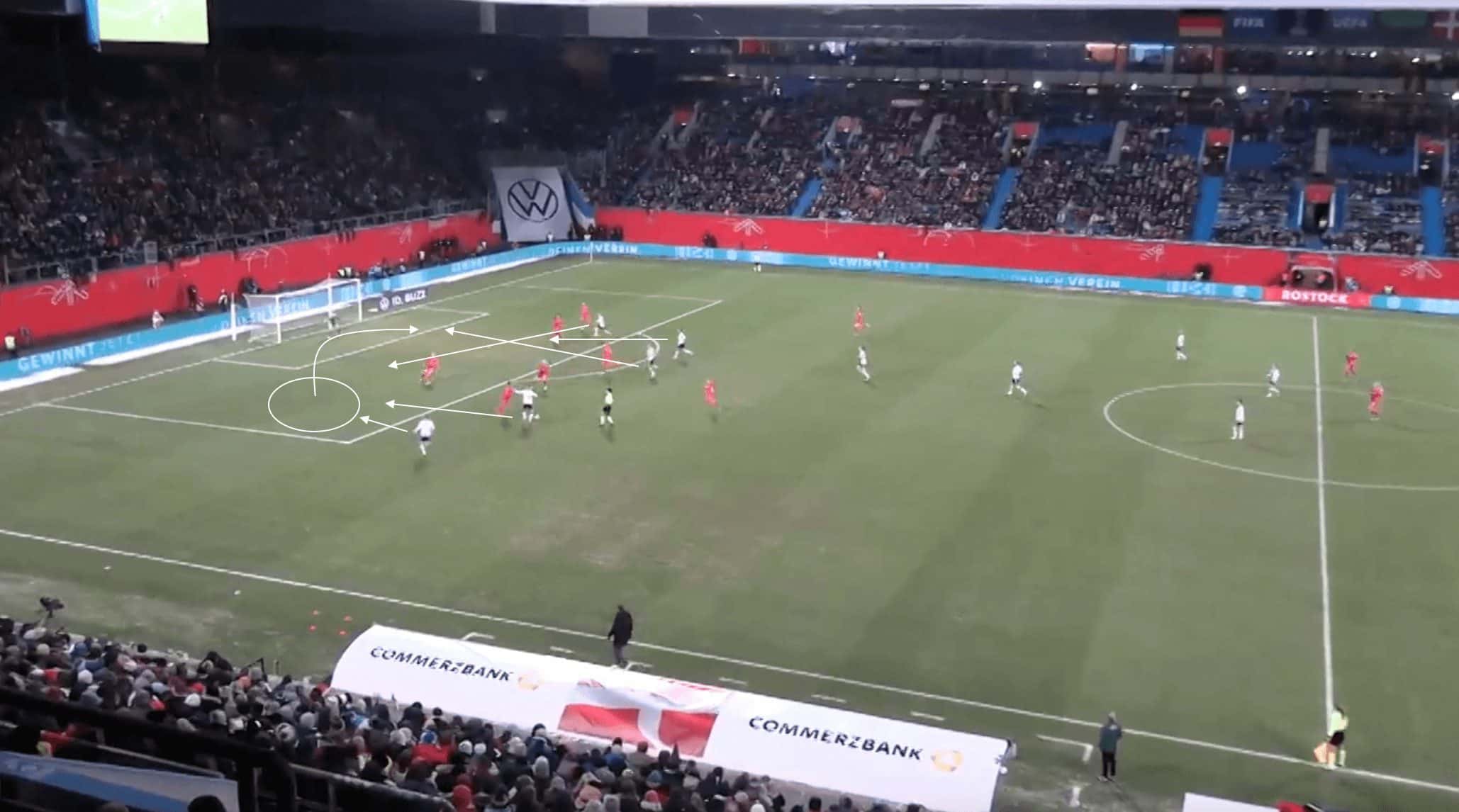
We can see above how this transitional phase for Germany ends.
After winning possession and finding the forward making a run in the channel, the forward faces up the Danish fullback and looks to run at her.
This forces the defender to get tucked inside, allowing the space for the German fullback to overlap beyond into the vacated space.
In the central area between the posts, three German players make runs into the penalty box, confusing the opposition defence.
The furthest German player makes a run across goal and towards the near post area, while the closest player makes a back post run, with the final player making a slot run and sitting just above the penalty spot.
Once the Danish defender is off balance, the ball is played into the path of the overlapping fullback, with the defender playing a cross towards the back post area for the attacker to head past the goalkeeper.
While they are not a side that looks to always play in transition, Germany are extremely dangerous in transitional moments, with this mainly down to the talent that they possess all over the squad, as well as the work rates they possess.
Forwards
When it comes to the forwards for Germany, their main task will be to score goals, and they all have been prolific at club level, especially this season.
Alexandra Popp has scored nine goals in all competitions for Wolfsburg this season, while Lea Schüller managed 14 goals in all competitions for Bayern Munich this season.
Laura Freigang is another forward likely to contribute to the German attack.
Although she has scored 13 goals for Eintracht Frankfurt this season, there is a high probability she will be trying to do most of her damage coming off the bench.
All three have also attempted plenty of shots per match this season, with all three being near the top of the Frauen Bundesliga charts in this category.
For more context, Popp leads the way with her 3.76 shots per 90 minutes, with Schüller being just behind with 3.75 shots per 90 minutes.
Freigang ranks 10th on the list but still attempted 2.48 shots per 90 minutes last season.
All three are also very good at attempting shots aerially, with all three ranking in the top five for headed shots in last season’s Frauen Bundesliga (Popp 14, Schüller 12, Freigang 8).
Midfielders
When talking about the midfielders for Germany, their ability to progress the ball vertically, as well as the defensive capabilities of the defensive midfielders in particular, will both be important for Germany as they go for another Olympic gold medal this summer.
Starting with ball progression, Lena Oberdorf has been essential to progressing play forward for Wolfsburg this season, and this is justified by her 10.39 passes to the final third per 90 minutes last season, one of the highest totals in the Frauen Bundesliga.
Oberdorf has also been impactful from a defensive perspective this season, with the Wolfsburg midfielder averaging 9.92 defensive duels per 90 minutes.
For Chelsea in the WSL, Sjoeke Nüsken averaged 5.56 passes to the final third per 90 minutes while also averaging 5.42 defensive duels per 90 minutes.
The more advanced midfielders will offer more of an impact with their ability to provide assists closer to goal, and both likely starters have had decent seasons when it comes to providing goalscoring chances for teammates.
Bühl led the FrauenBundesliga this season with nine assists, while Jule Brand only had two assists, but her impact came with her ability to get on the ball in the penalty area.
The 21-year-old had the most touches in the penalty area per 90 minutes in Germany with 57, while her 6.5 touches per 90 minutes was the second highest.
Defenders
With how aggressively Germany like to play defensively, the defenders for Hrubesch’s side will need to be at their highest level from a defensive standpoint this summer if they are to have any chance at taking home the goal medal.
Giulia Gwinn has averaged 9.27 defensive duels per 90 minutes for Bayern Munich this season, with the fullback on the opposite side, Sarai Linder, averaging 5.95 defensive duels per 90 minutes.
In the central areas, Hendrich and Doorsoun have shown their ability in defensive duels this season, with Hendrich averaging 7.51 defensive duels per 90 minutes and Doorsoun slightly less at 5.29 defensive duels per 90 minutes.
Key player
When looking at this German squad, it is hard to pick one player who could be considered key, as all of them have the capability, but it is hard to look past Lena Oberdorf.
The 22-year-old Wolfsburg midfielder has been immense for the German side in recent seasons and will be joining Bayern Munich this summer.
Oberdorf is an all-action midfielder, looking to dictate play from deeper areas in the midfield and being heavily involved in the defensive side of the game.
She also pops up in attacking areas, with five goals and three assists for Wolfsburg in the Frauen-Bundesliga for the 2023/24 season.
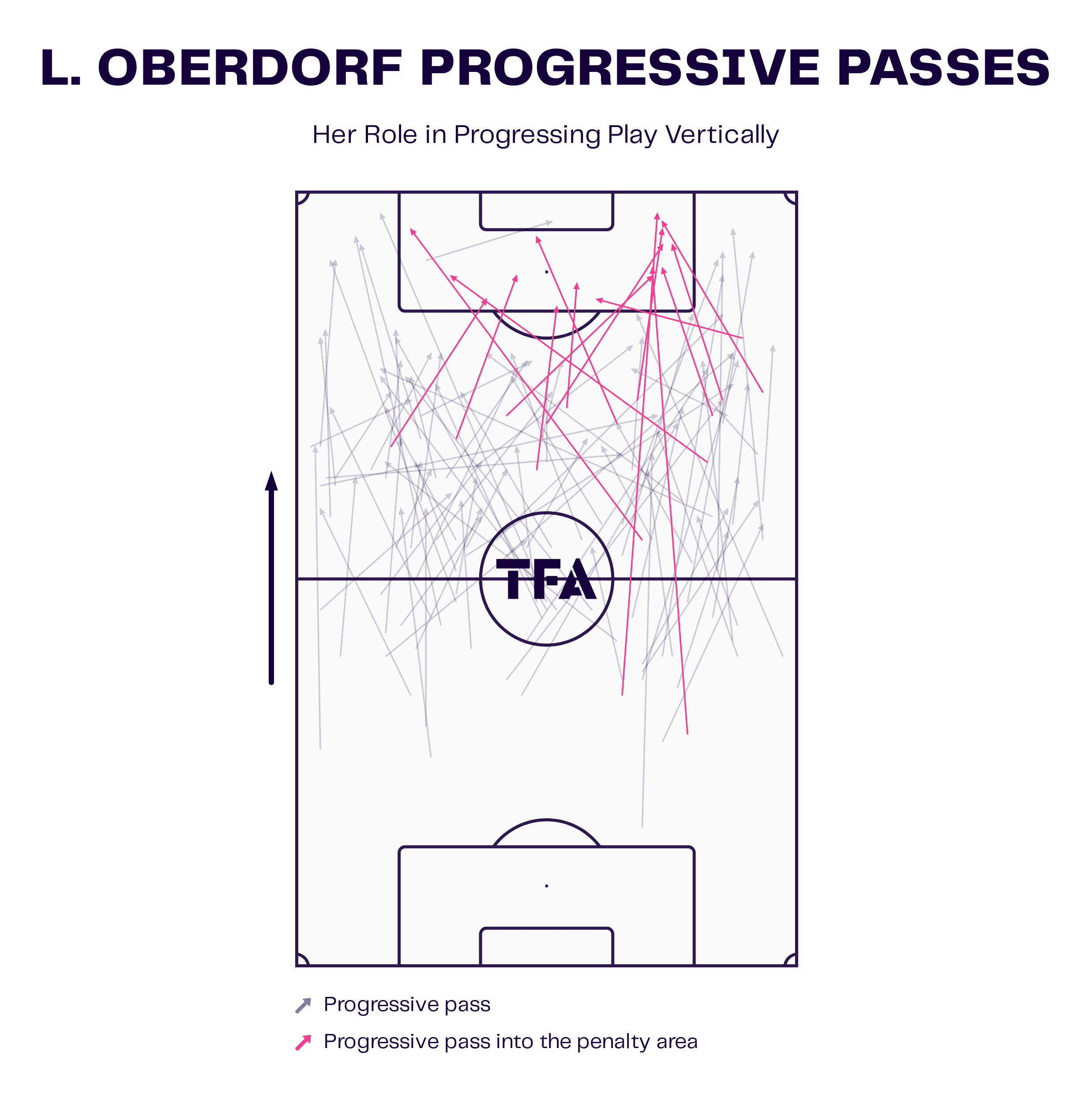
We touched briefly on this earlier, but we can see from the graphic above how impactful Oberdorf looks to be from deeper-lying positions in midfield.
The data viz above shows her progressive pass map, which shows us how a good amount of her progressive passes have come from inside the defensive half or just inside the attacking half, highlighting her tendency to play more as a deep-lying playmaker at club level for Wolfsburg.
She will likely be tasked with being a deep-lying playmaker for Germany at the Olympic Games this summer, and her ability to play as a box-to-box midfielder will also benefit how Germany will want to set up.
Oberdorf has shown on the brightest stages before, and this will be another time for her to showcase her talents to the world before joining Bayern Munich this summer and embarking on the next step of her club career.
Tournament prediction
Looking at the group they have been drawn into for this tournament, it looks to be a straight shot between Germany and the United States to see who will win the group and who will finish second and advance to the knockout stages.
Germany should go far in this tournament based on the quality of their squad, but the same thing was said last summer before they went out in the group stages of the World Cup.

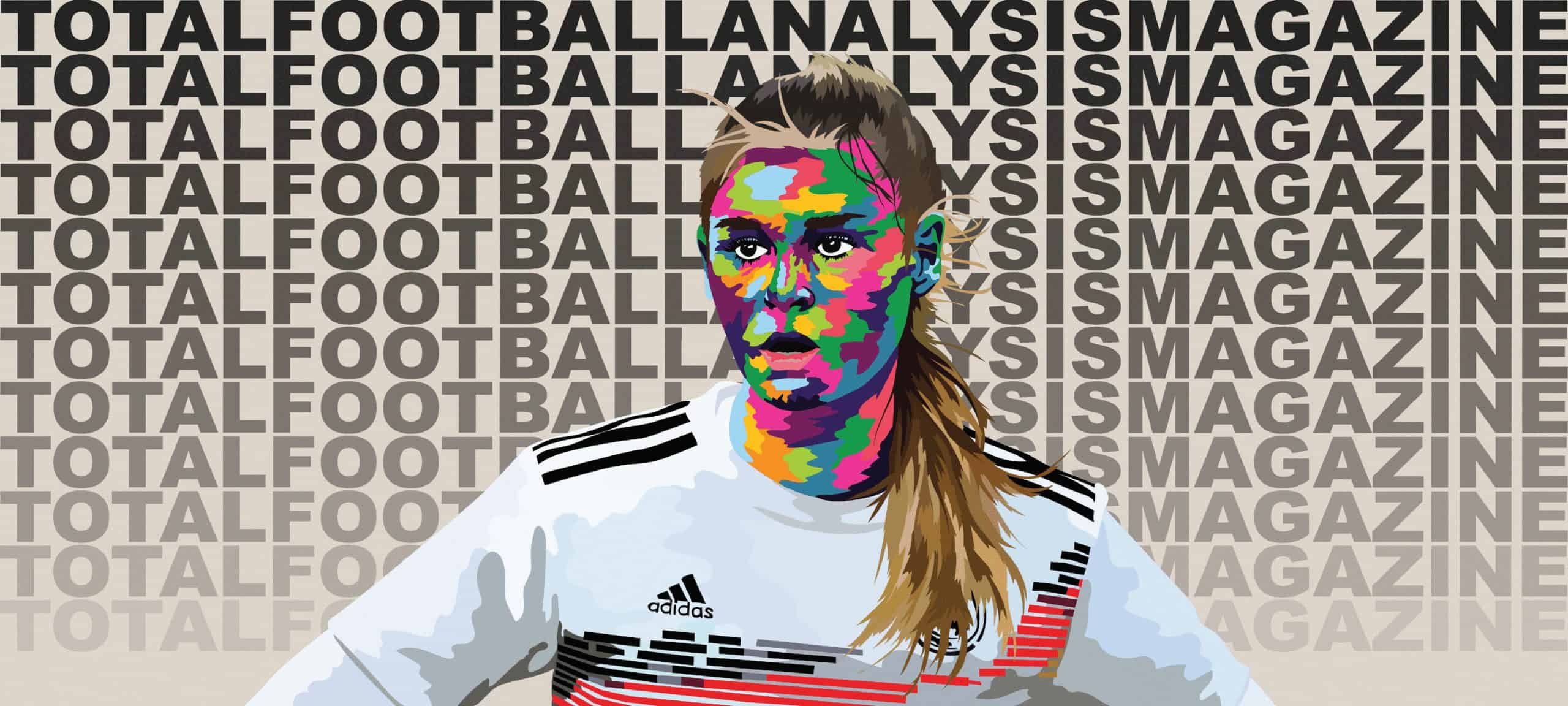



Comments